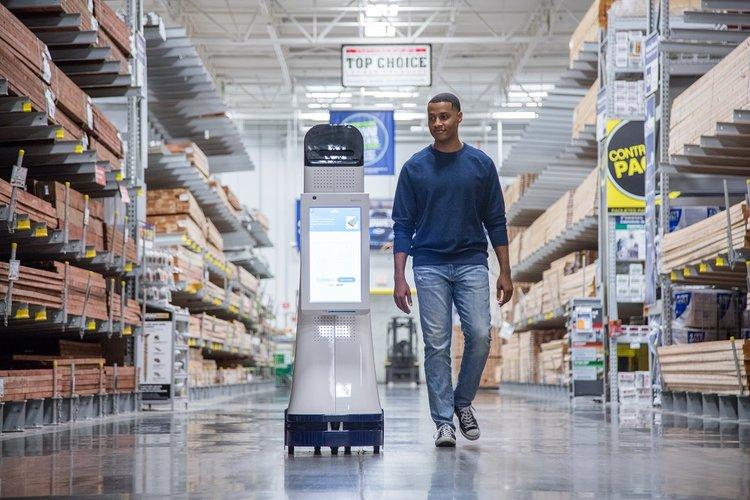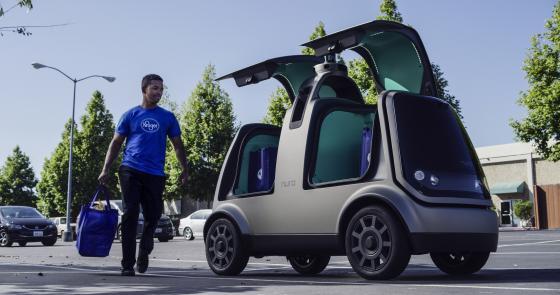Retail Robotics: Productivity, Efficiency and Compliance
Retail robotics are no longer science fiction. Automation is increasingly infiltrating the store, the warehouse, and the road as retailers pivot their strategies to become more customer-centric and to handle the inventory and fulfillment needs of today’s omnichannel orders.
“Retailers are moving toward a world of short-term replenishment; instead of replenishing in bulk weekly, some are moving to a faster, even daily approach,” J. P. Gownder, VP and principal analyst on Forrester’s CIO team told Forbes. “All of these changes require automation and intelligence.”
From inventory monitoring and picking in the warehouse, to providing information to shoppers and supporting last-mile fulfillment, automation implementations continue to rise. Retailers require new skills from their workforces, and employees are already being tasked with learning how to work with a influx of technology. Meanwhile, overall employment of retail sales workers is projected to grow 2% from 2016 to 2026, slower than the average for all occupations, according to The Bureau of Labor Statistics.
While concerns swell that automation could compound job losses in the retail industry, there’s no ignoring that many high profile retailers are testing out and investing in retail robotics. Here we take a look at three ways robotics are already being put to use in the retail industry.
Productivity
Savvy retailers have known for years that brick and mortar stores need to evolve to cater to the customer experience if they are going to survive in a climate where most items can be easily purchased from the comfort of shoppers’ homes. One way retailers have sought to do this is to free up employees’ time to focus on the customer, leveraging both workforce technology tools and experimenting with robots. Rather than go all-in on technology that distances customers from associates, retailers are investing in technology that automates routine tasks for associates, those which once prevented them from engaging with customers.
Lowe’s was an early adapter of robotics tech, introducing an autonomous retail service robot dubbed LoweBot in 2016. The robots were rolled out to 11 Lowe’s stores throughout the San Francisco Bay area following a successful robotics test of OSHbot at one of the company’s Orchard Supply Hardware stores. LoweBot was able to find products in multiple languages and help customers effectively navigate the store.
“As LoweBot helps customers with simple questions, it enables employees to spend more time offering their expertise and specialty knowledge to customer,” Lowe’s noted on its Innovation Labs site.
Beyond helping shoppers in the aisle, The Kroger Co. has been working on solutions outside the store, to cope with increasing customer demand for grocery delivery. Since the grocer’s pilot launched in 2018 in Scottsdale, AZ, Kroger and robotics company Nuro have been expanding their autonomous grocery delivery service, bringing it to Houston, TX, in April. Like the first pilot market, Kroger and Nuro are starting the service with Nuro's manual and self-driving Toyota Prius fleet, and plan to introduce the next generation of Nuro's custom driverless vehicle later this year.
"Our Arizona pilot program confirmed the flexibility and benefits provided by autonomous vehicles and how much customers are open to more innovative solutions," said Yael Cosset, Kroger's chief digital officer. "It's always been our shared vision to scale this initiative to new markets, using world-changing technology to enable a new type of delivery service for our customers.”
FedEx Corp. also unveiled an autonomous delivery robot this year, the SameDay Bot, to help retailers make same-day and last-mile deliveries to their customers. As shoppers’ demands for same-day delivery have been heating up, FedEx is collaborating with companies such as AutoZone, Lowe’s, Pizza Hut, Target, and Walgreens to help assess retailers’ autonomous delivery needs. FedEx plans to test the bot this summer in select markets, including Memphis, TN, pending final city approvals.
Unlike Kroger’s self-driving pilot, the FedEx bot is designed to travel on sidewalks and along roadsides, safely delivering smaller shipments to customers’ homes and businesses. Next-gen technology allows the bot to navigate unpaved surfaces, curbs, and even steps for a door-to-door delivery experience.
Efficiency
Increasing demands for speedy fulfillment don’t just impact the last mile.
“Flexibility and efficiency have become primary differentiators in the e-commerce fulfillment market as retailers and Third-Party Logistics (3PLs) struggle to cope with volatile product demand, seasonal peaks, and rising consumer delivery expectations,” said Nick Finill, senior analyst at ABI Research. “Robots enable warehouses to scale operations up or down as required while offering major efficiency gains and mitigating inherent challenges associated with labor and staffing.”
To this end, on top of its self-driving delivery plans, Kroger has set out to transform warehouse operations for its network of supermarkets. The grocer and UK-based online supermarket Ocado have developed an exclusive partnership to bring the technology underpinnings of the Ocado Smart Platform, which includes online ordering, automated fulfillment and home delivery capabilities, to the U.S.
Kroger has committed to building 20 customer fulfillment centers (CFC), powered by Ocado, to accelerate its fulfillment capabilities. The CFC model – an automated warehouse facility with digital and robotic capabilities, also known as a "shed" – will be replicated to serve Kroger customers across America.
"Kroger is excited to partner with Ocado—one of the most innovative, advanced companies in the world—to redefine the grocery shopping experience for customers along the East Coast," said Rodney McMullen, Kroger's chairman and CEO.
Kroger and Ocado so far have announced three CFCs of the 20 that they aim to build: Monroe, OH, central Florida and the Mid-Atlantic.
With the aim of efficiently fulfilling orders inside stores, last year Zara turned to robots to automate its click-and-collect service. The fashion retailer's London flagship store tested an automated online order collection point serviced by two small warehouses. The system is designed around an optical barcode reader which scans the QR code or accepts the PIN codes received by customers when they place orders online. After a shopper scans the code, a dynamic robot moves through the warehouse and in just a few seconds, it delivers the order to a mailbox where the shopper can collect it. Zara claims the robot has the capacity to handle 2,400 packages simultaneously.
As e-commerce orders boom and retailers search for ways to meet a new level of efficiency, some are turning to automated solutions, including autonomous mobile robots (AMRs) in the warehouse.
“AMRs ensure the quick and accurate flow of goods within the warehouse, which is critical for managing the flow of reverse logistics and prompt delivery to stores,” explains the Robotic Industries Association. “The accuracy, efficiency and productivity that AMRs deliver can have reverberations throughout the whole organization. Retailers that can cut operational costs while improving service are better positioned to compete with the rapid rise of e-commerce.”
By 2021, 60% of the world's 2,000 largest companies will have deployed autonomous mobile robots, according to IDC research director John Santagate.
"The worldwide market for commercial service robotics will continue to grow at a rate of 20% per year for the coming five years,” he noted. “We expect to see growth driven by increased adoption of autonomous mobile robots and collaborative robots being deployed as a means to deliver improvements in capacity, productivity, and efficiency.”
COMPLIANCE
One of the highest profile stories on robotics in retail this year is Walmart’s plans to deploy in-store robots across its 5,000 US locations. To help to mega retailer deal with compliance issues, the rollout includes 1,500 autonomous cleaning machines, 300 shelf-scanning robots, and 1,200 automated truck unloaders.
The planned rollout of 1,500 autonomous floor scrubbers were in addition to those already in use in over 200 stores. Dubbed “Auto-C” the machine can be programmed to travel throughout the open parts of the store, leaving behind a clean, polished floor. Associates can reprogram routes as store layouts are changed.
“Our associates immediately understood the opportunity for the new technology to free them up from focusing on tasks that are repeatable, predictable and manual,” said John Crecelius, senior VP of central operations for Walmart U.S. “It allows them time to focus more on selling merchandise and serving customers, which they tell us have always been the most exciting parts of working in retail.”
In addition, automated “Auto-S” shelf-scanning robots are being added to travel store aisles and scan items on store shelves to help ensure availability, correct shelf location, and price accuracy. Working along with the shelf scanner bots, the 1,200 additional FAST Unloaders will automatically scan and sort items unloaded from trucks based on priority and department, with the aim of helping associates to move inventory from the back room to the sales floor faster.
In a similar vein, Schnuck Markets’ and Giant Eagle have both turned to a partnership with Simbe Robotics to deploy an autonomous shelf auditing and inventory analytics solution named Tally. Schnuck Markets’ added the shelf-scanning robot to at least 15 stores last year after piloting the tech in 2017, when Tally began capturing deeper, real-time insights into on-shelf operations at three Schnucks locations.
“Tally has been instrumental in boosting the way our shelves are managed and how our stores function,” said Dave Steck, VP of IT, infrastructure and application development, Schnucks. “As a result of working with Simbe, we’ve experienced a phenomenon we call ‘The Tally Effect,’ an immediate improvement in in-store operations and increased teammates productivity.”
Following suit, Giant Eagle just launched its own pilot program with the Tally robot in April in the Pittsburgh, Cleveland, and Akron markets. Tally robots in Giant Eagle and Market District traverse the floors multiple times per day, scanning approximately 35,000 products. Tally then sends detailed data reports to Giant Eagle store teams every 30 minutes that capture, report, and analyze the state and availability of merchandise. These reports help employees to focus on controllable out-of-stock and pricing situations, while optimizing each store’s product layout.
Meanwhile, shoppers in Stop & Shop and Giant/Martin’s stores will see robots named Marty roaming the aisles. The grocer is rolling out nearly 500 of the robots from a partnership between Retail Business Services – the services company of parent company Ahold Delhaize USA – and Badger Technologies, after pilots that improved in-store efficiencies and safety. The in-store robots were tested and used to identify hazards, such as liquid, powder and bulk food item spills and provide reporting that enables corrective action. They reportedly help stores mitigate risk caused by such spills.
“Bringing robotics and A.I. from a research lab to the sales floor has been a very exciting journey, and we were thrilled by the customer response in our pilot stores,” said Nicholas Bertram, president, Giant Food Stores. “Our associates have worked hard to bring this innovation to life with amazing partners.”
Conclusion
Major robot tests are underway in stores today, and they’ve already transformed supply chain operations in many retail warehouses and distribution centers. By 2025, it’s estimated that more than four million commercial robots will be installed in over 50,000 warehouses, up from just under 4,000 robotic warehouses in 2018, according to ABI Research. Innovations in computer vision, AI, deep learning, and robotic mechanics are all helping robots to become increasingly adept at performing traditionally harder-to-automate tasks.
“If advanced automation becomes possible for mid-size e-retailers, they will be able to fight back against the dominant players and also bring fulfillment operations back in-house, disrupting the relationship between retailers and 3PLs,” said Finill.
As retailers rapidly approach the dawn of the robots in retail, it’s important to consider how, when and if you will make use of this burgeoning tech.







